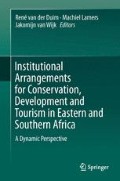Abstract
Prior to Namibia’s Independence in 1990 tourism on communal land in Namibia was dominated by white-owned businesses. Tourism brought little benefit to the people living on the communal land. They mostly had menial jobs as cleaners and gardeners or possibly as cooks. In 1996 the Namibian Government introduced legislation that gave communal area residents rights over wildlife and tourism on their land if they formed common property resource management institutions called conservancies. The conservancies have become central in the evolution of new institutional arrangements for community involvement in tourism. One of the main ways in which conservancies earn income is through “joint venture” tourism development in some form of partnership with the private sector. This chapter first considers the evolution of the conservancy institutional approach. It then compares different models of community involvement in tourism in relation to issues of community ownership, exposure to business risk and maximising income.
Access this chapter
Tax calculation will be finalised at checkout
Purchases are for personal use only
Notes
- 1.
The PTO system has since 2002 been replaced by the issuing of leases for tourism businesses on communal land by Communal Land Boards established under land legislation.
- 2.
Usually the leasehold rights.
References
Barnes, J., & Jones, B. (2009). Game ranching in Namibia. In B. Child, H. Suich, & A. Spenceley (Eds.), Evolution and innovation in wildlife conservation in southern Africa (pp. 113–126). London: Earthscan.
Berkes, F. (Ed.). (1989). Common property resources. Ecology and community-based sustainable development. London: Belhaven Press.
Bond, I. (1999). CAMPFIRE as a vehicle for sustainable rural development in the semi-arid communal lands of Zimbabwe: Incentives for institutional change. Dissertation, University of Zimbabwe.
Elliott, J., & Sumba, D. (2011). Conservation enterprise: What works, where and for whom? London: International Institute for Environment and Development.
Jones, B. (2004). Principles, processes and products: Best practices in project design and implementation. Lessons learned from the Living in a Finite Environment Project, Namibia, 1993–2004. Windhoek: USAID.
Jones, B. (2008). Damaraland Camp case study. In B. Jones (Ed.), Namibian CBNRM program case studies of tourism enterprises in communal conservancies. Windhoek: NACSO/WWF Namibia.
Jones, B. (2010a). Ostrom and Namibian conservancies. Current Conservation, 4(3), 21–23.
Jones, B. (2010b). The evolution of Namibia’s communal conservancies. In F. Nelson (Ed.), Community rights, conservation and contested land: The politics of natural resource governance in Africa (pp. 106–120). London: Earthscan.
Jones, B. T. B., Davis, A., Diez, L., & Diggle, R. W. (2013). Community-based Natural Resource Management (CBNRM) and reducing poverty in Namibia. In D. Roe, J. Elliott, C. Sandbrook, & M. Walpole (Eds.), Biodiversity conservation and poverty alleviation: Exploring the evidence for a link (Conservation and science practice series). Chichester: Wiley-Blackwell/ZSL.
Lindsey, P. (2011). An analysis of game meat production and wildlife-based land uses on freehold land in Namibia: Links with food security. Harare: TRAFFIC East/Southern Africa.
Long, S. A., & Jones, B. T. B. (2004). Contextualising CBNRM in Namibia. In S. A. Long (Ed.), Livelihoods and CBNRM in Namibia: The findings of the WILD Project. Final Technical Report of the Wildlife Integration for Livelihood Diversification Project (WILD). Windhoek: Ministry of Environment and Tourism.
MET. (1995). Wildlife management, utilisation and tourism in communal areas. Policy document. Windhoek: Ministry of Environment and Tourism.
MET. (2007). Policy on Tourism and wildlife concessions on state land. Windhoek: Ministry of Environment and Tourism.
MET. (2013). Report on the Namibia tourist exit survey 2012–2013. Windhoek: Ministry of Environment and Tourism.
NACSO. (2013a). Namibia’s communal conservancies: A review of progress and challenges in 2011. Windhoek: NACSO.
NACSO. (2013b). Summary of conservancies. Retrieved September 19, 2013, from http://www.nacso.org.na/SOC_profiles/conservancysummary.php
Nelson, F., & Agrawal, A. (2008). Patronage or participation? Community-based natural resource management reform in sub-Saharan Africa. Development and Change, 39(4), 557–585.
Newsham, A. (2007). Knowing and deciding: Participation in conservation and development initiatives in Namibia and Argentina. Dissertation, University of Edinburgh, Centre of African Studies.
NTB. (2008). Namibia tourism satellite account. Windhoek: Namibia Tourism Board.
Ostrom, E. (1990). Governing the commons. The evolution of institutions for collective action. Cambridge: Cambridge University Press.
Ruggles-Brise, O., & Aimable, E. (2012). Travel and tourism economic impact 2012 Namibia. London: World Tourism Council.
Author information
Authors and Affiliations
Corresponding author
Editor information
Editors and Affiliations
Rights and permissions
Copyright information
© 2015 Springer Science+Business Media Dordrecht
About this chapter
Cite this chapter
Jones, B.T.B., Diggle, R.W., Thouless, C. (2015). From Exploitation to Ownership: Wildlife-Based Tourism and Communal Area Conservancies in Namibia. In: van der Duim, R., Lamers, M., van Wijk, J. (eds) Institutional Arrangements for Conservation, Development and Tourism in Eastern and Southern Africa. Springer, Dordrecht. https://doi.org/10.1007/978-94-017-9529-6_2
Download citation
DOI: https://doi.org/10.1007/978-94-017-9529-6_2
Published:
Publisher Name: Springer, Dordrecht
Print ISBN: 978-94-017-9528-9
Online ISBN: 978-94-017-9529-6
eBook Packages: Earth and Environmental ScienceEarth and Environmental Science (R0)

